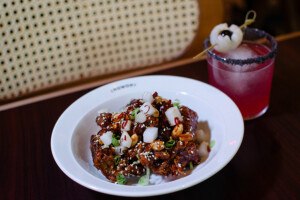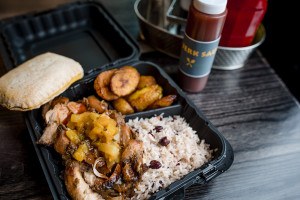The Future of Junk Food Returns to Boston

An upscale Snickers bar made with chicken liver mousse, Vietnamese caramel, and Thai basil. Photo provided by Brian Samuels
On December 14, chef Sam Monsour will return to Boston to team back up with current Shojo chef Mark O’Leary for the sixth and final Future of Junk Food pop-up dinner in their ongoing Kitchensurfing series. Monsour, who moved to Los Angeles in August, has been continuing his haute junk food crusade from across the country while keeping busy with his upcoming cookbook and his line of Project Hunger chefs aprons.
We caught up with the two chefs to discuss the series’ future after their Kitchensurfing partnership, their massive Christmas-themed fête at Shojo, and their quixotic plan to bring “wholesome” junk food to Frito-Lay.
Mark, you were with Sam recently in L.A. for the Future of Junk Food pop-up dinner there, right?
O’Leary: Correct, in October. That was our first event outside of Boston and it was a fucking blast. It was very well received. Sam has a number of great friends out there that contributed to the dinner. We had Jeremy Fox and Marcel Vigneron from Top Chef and Beefsteak. A lot of cool people helped us out, so it was really fun.
Where did you host the event?
Monsour: It was at this spot called Huckleberry Cafe in Santa Monica. Those owners, Josh Loeb and Zoe Nathan, also own Rustic Kitchen where Jeremy Fox is the chef and a place called Milo and Olive and a number of small-batch ice cream creameries. They close on 5 p.m. on Sundays, so we were able to sneak in there after we prepped everything over at Rustic Kitchen, which is across the street. It was all family and all love. We couldn’t have done it without that restaurant group.
Sam, how’s the transition to California been working out for you?
Monsour: It’s been an emotional roller coaster of excitement, missing people, being confused about how shit works, being violently frustrated in traffic because it can take a half-hour to go a half-mile. You hear that but you don’t know what that means until you’re in it and just losing your mind.
Was this always the plan, to come back occasionally and do some pop-up events here in Boston?
O’Leary: We sort of fly by the seat of our pants. Originally, we had no real plan for it, we just knew that we wanted to commit to six dinners with Kitchensurfing as a sponsor, and they’ve been great. Occasionally an opportunity arises like the L.A. event. We want to wrap up our commitment in our hometown now, with Shojo as the venue.
How big will this event be?
Monsour: We’ll seat 60 people, so this will be the largest event we’ve done. At La Brasa we did 56 and in Santa Monica we did 56. We were slowly building up to test those waters and see if we could do about 60 people because it is our dream to one day do a Junk Food dinner at the Beard House, which seats about 60. We don’t know if that’s ever going to happen, but it would be super cool.
How feasible is a Beard House dinner? Have there been any conversations about that yet?
Monsour: We’re trying to and it seems like it’s a possibility. I’m just throwing it out there because it’s been part of our dream since we started this. To second what Mark said, we fly by the seat of our pants. We really do. The series could potentially go to 15 dinners, or it could just end at six. I’m not sure. But if the finale were at the Beard House, that would be very cool. But we’re always working on what’s next for the Future of Junk Food. We don’t want it to get stale. It’s not always going to be a pop-up dining experience with five courses. The new year is going to mean a new layout and formula. Can we turn it into a street vendor thing that’ll seat a thousand people? That’s the kind of question we’ve been asking ourselves.
O’Leary: Yeah, can we take over the Frito-Lay factory? Maybe, we don’t know.
I know you’re just throwing out a hypothetical situation, but that would still be a pop-up. Would you ever transition the concept into something more permanent like a food truck or brick and mortar restaurant?
O’Leary: We’re not against anything. Whatever ends up being fun and getting the message across, we’re all for. The fun part about the Future of Junk Food is that it isn’t just one thing. It isn’t just a pop-up, it’s this ever-evolving blob of fun and positivity.
Up until now the Future of Junk Food has been a multi-course dinner that isn’t exactly cheap. As you being to contemplate some new ideas, will you look at junk food alternatives that are not only better for you, but also affordable?
O’Leary: Yes, that’s the ultimate endgame. We want people to buy into eating a little more pure and wholesome. The problem is that we have to spend our money in places that support our vision. That will change down the road.
Monsour: A lot of chefs right now, Mark and I especially, want to help more people get access to better food. Not necessarily more healthy food or calorie-counting food, but food that was raised and grown with integrity. We were just trying to have a lot of fun and be creative by turning foie gras and uni into junk food. That was part of our creative vision with this, but our endgame is to turn this into something practical. We want to make junk food people can actually get their hands on. Our culture is dependent on convenience and affordability, and that’s fine. That’s been part of our country since it was founded. That’s not some new thing. We love to eat, and that’s fucking beautiful. Mark and I want to embrace that, but tie in sustainability.
So has the pop-up format limited what you can do with the overall concept?
O’Leary: With the pop-ups, we’re really trying to create an experience. We could make a bunch of Filet-O-Fish sandwiches and sell them on a street corner for $5 apiece, but I don’t think the message would be quite as potent. Like Sam keeps saying, we don’t want to be preachy. We want people to have fun, but still come away with something to chew on. No matter how wacky our dishes are, they’re made with actual food. We don’t have a laundry list of ingredients that you have to Google to figure out what they are.
Monsour: When we were doing junk food at JM Curley’s, people were loving it and it was in the same vein, but it didn’t give us a platform to talk about what we’re trying to do. We had to elevate the experience. We’ve spent the last year doing that and raising awareness. Now it’s gone beyond just a tongue-in-cheek seasonal menu to an actual brand. That’s going to allow us to go backward and make these attainable products. We started out with beet Doritos, which was just a really cheap bar bite. Doritos makes new flavors all the time. You never know.
This is now your sixth event with Kitchensurfing, do you think you’ll do future events with them?
Monsour: We would love that. We like their visions and their culture as a company. We’ve been able to get this far because of the support and sponsorship they’ve given us. Avery Gordon, who is the general manager of Kitchensurfing in Boston, has essentially become our partner in designing this series. She doesn’t get enough credit and I can’t speak highly enough about her.
Are there target cities outside of Boston and L.A. where you’d like to throw Future of Junk Food events?
We want to got to all the cities that Kitchensurfing is in, so Seattle, Washington D.C., Chicago, and New York. Even we could dinners in those four cities, we’d feel like we accomplished something with this series.
Can you tell me what the theme of the new menu will be at the Shojo event?
Heavy, heavy, heavy Christmas nostalgia.
Dec. 14, 6:30 p.m. cocktail reception, 7 p.m. dinner, 9 Tyler St., Boston; kitchensurfing.com/boston.


